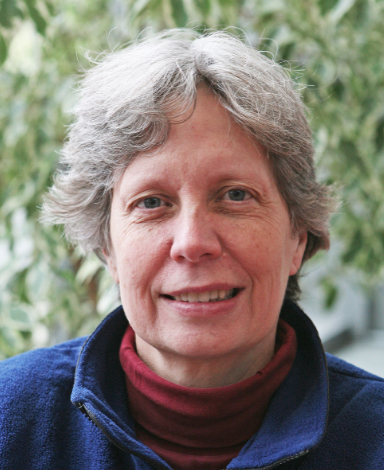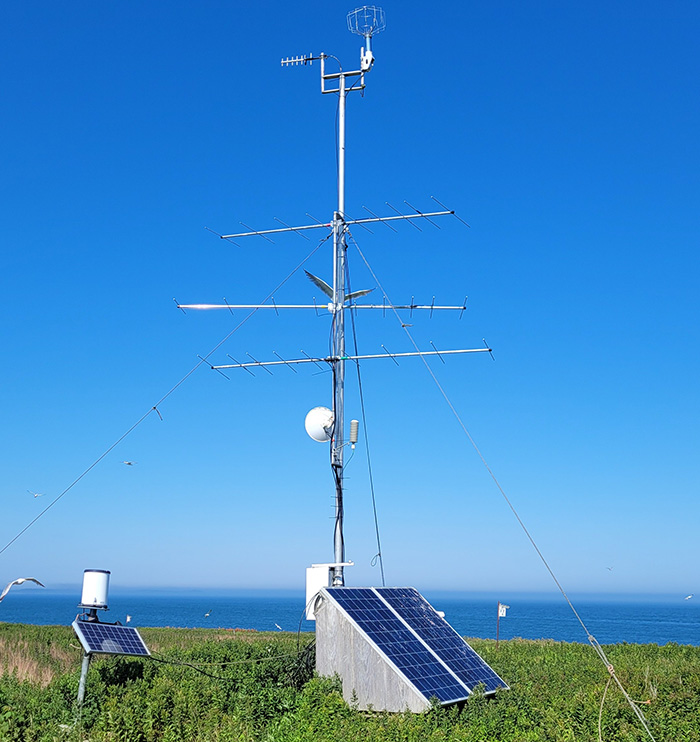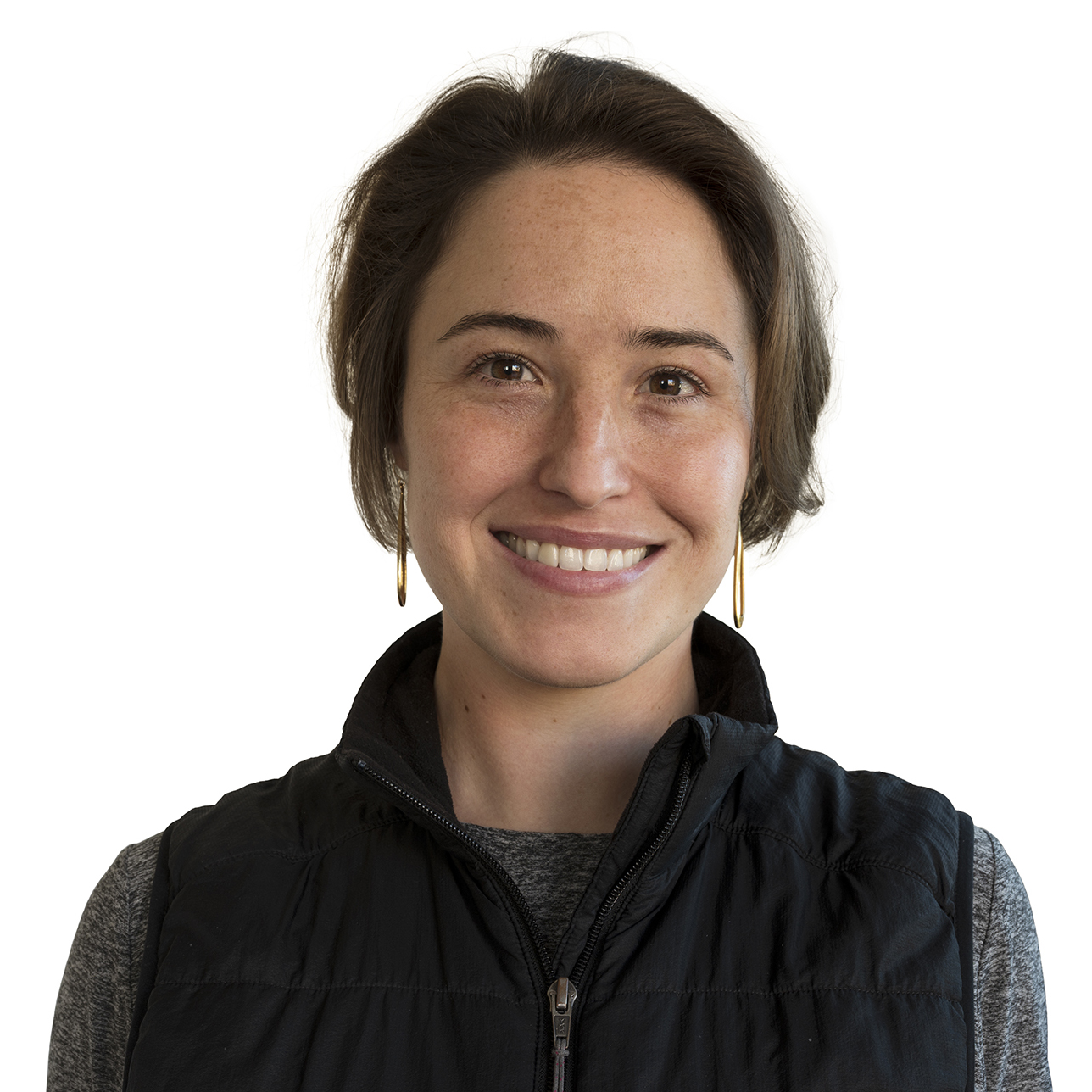Oasis of Opportunity: The Bowdoin Scientific Station on Kent Island
By Bowdoin NewsYou hear how amazing the Bowdoin Scientific Station (BSS) is, sitting there amid two hundred acres of lush nature, such an opportunity for students to do hands-on scientific work to help continue its legacy of decades-long research data—and also that it takes forever and multiple modes of transportation to get there. All of this is true.
At once six miles south of Grand Manan Island in the Bay of Fundy and halfway between Maine and Nova Scotia, Kent Island is indeed a haven in every sense of the word.
Virtually predator-free, the island is a sanctuary for birds, specifically Leach’s storm-petrels, which have been studied here since the early 1930s and whose species is threatened; Savannah sparrows, whose birdsong has been the subject of decades of research by renowned animal behaviorist and neuroscientist Heather Williams ’77 and the career-long research system of retired biology professor and former BSS director (1987–2004) Nat Wheelwright; and seagulls that you will effortlessly anger if you venture anywhere near their eggs or young, which are everywhere.
Since 1936, when John Sterling Rockefeller donated the island to Bowdoin in exchange for a dollar and a promise that the College would maintain it as a bird sanctuary, Kent Island has been an ideal oasis for researchers who study all things avian and an inspiring retreat for artists, who, like the island itself, can’t help but find themselves surrounded by wondrous nature’s everchanging conditions poetically juxtaposed with the nearly two-mile long strip of land that remains pristine and largely unaffected by modern advances.
The (Bird) Song Does Not Remain the Same
“After my first year I worked two jobs over the summer so I would be able to spend all of the following summer on Kent Island. It was one of the foggiest summers on record, and I spent it having as many adventures as is possible on a small island.”
Heather Williams ’77 on the cultural evolution of bird song »
Make no mistake; it is also a trek. You can’t get there from here or from anywhere easily, but the challenge makes your arrival that much more satisfying. Suffice it to say, if you were to leave from the Bowdoin campus, you’re going to drive forever, or four hours, but will take in beautiful blueberry barrens in down east Maine before you cross the border into Canada.
Once abroad, you will continue to drive until you board a ferry with your vehicle bound for the north end of Grand Manan Island and then traverse to the south end, where you’ll be picked up by a kind bearded man piloting a skiff, who, depending on the tide at that particular moment, may also later help you and your gear into a dinghy and then row you ashore. And ashore is a relative term, again depending on the tide. The Bay of Fundy is quite known for its tidal changes, which typically range more than forty-five feet from high to low. Ashore may actually mean “almost there,” and you’ll be glad you followed the recommendation to bring along eighteen-inch tall boots so that you may wade through the muck of the drained basin that meets what you and I think of as “the shore.”
As it turns out, the kind bearded man is Ian Kyle, who is—plot twist—also the BSS assistant director, a Bowdoin alumnus (Class of 2006) who came to Kent Island himself as a student and—spoiler alert—married to Patricia Jones, the BSS director. All of this to say, students who come to Kent Island obviously really want to be here and are beyond grateful for the opportunity, which is the word you hear again and again.
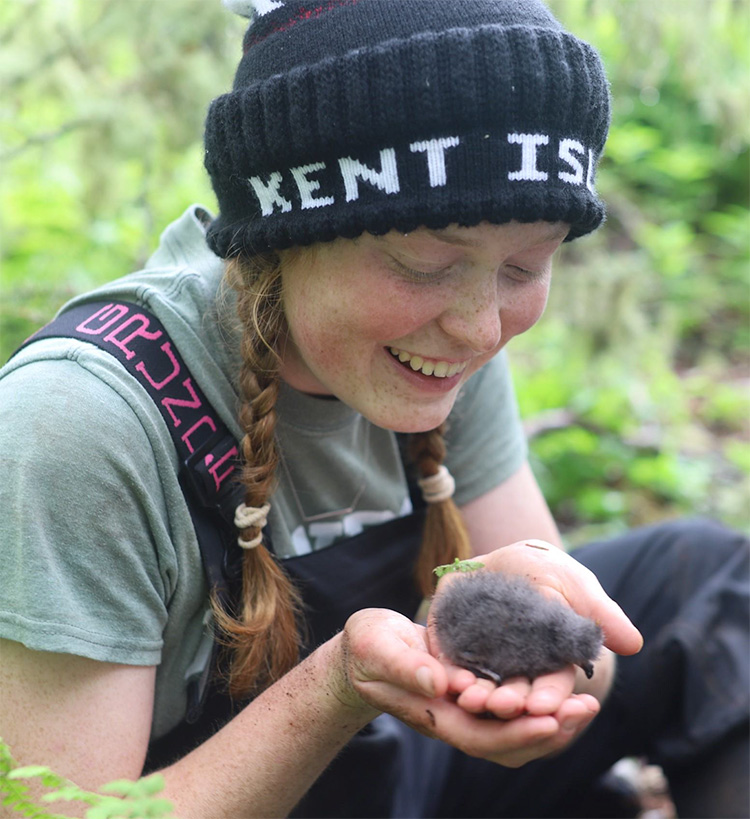
Chicks Dig It: The Legacy of the Leach’s Storm-Petrel
Megan Stretch ’24, a rising junior from San Mateo, California, shoulders quite a responsibility over the summer, in part because she spends a great deal of time in an area of the island known as the shire, reaching shoulder-deep into the burrows of delicate storm-petrel chicks in order to safely retrieve them, and also because she has a crucial role in the island’s legacy of maintaining one of the oldest continuous data sets on animals in the world. There is some data on storm-petrels dating back to the early 1930s; continuous data collection began in 1953.
“They are just an incredible species,” says Stretch. “They're burrowing seabirds. They live underground. They lay one egg a year. A lot of times they’ll prioritize their own survival over that of their chick’s, so in the face of climate change in terms of ocean warming and declining food sources, it’s interesting to see how these threatened birds manage their energy and the different strategies they use.”
Stretch checks multiple storm-petrel burrows every day, recording their weight and compiling a population census. BSS director Patricia Jones helped design load cell sensor devices—scales, essentially—that are placed at the entrance of the burrows to measure the birds as they come and go, reducing the number of times researchers must physically remove the birds.
Storm-petrels are an important part of the island’s history and fascinating creatures. Laying one egg at time, they smell musty as chicks, can sometimes live to be thirty-eight years old, and are surprisingly well traveled. For years, BSS researchers wondered where they went when they disappeared for days at a time. A few years ago, having outfitted more than a dozen of the little guys with tiny backpacks carrying GPS devices, Kent Island researchers were able to stalk their movements.
“They fly from Kent Island all the way down, past Brunswick, to Cape Cod to find food,” Jones explained. “The trip takes them three or four days, then they return to Kent Island and trade out with their mate who was sitting on their egg in their little burrow in the ground, so that their mate can head out and find food.” Read “A Seabird Mystery is Solved on Kent Island.”
Getting to work with data going back to the early 1950s when the island’s storm-petrels were first banded connects today’s researchers through time to something bigger than just the part of the summer they spend on the island. “I think it's incredible,” says Stretch. “I've never done field research before, and I'm kind of testing out which field of bio I would love to go into. And this opportunity is amazing.”
The Kent Island Experience: A Summer of New and Unique Opportunities
For nine weeks each summer here, students like Megan Stretch are the researchers, a unique experience in an undergrad environment. This summer nine Bowdoin students have journeyed to the island: six research fellows, one artist-in-residence, and two land stewards. They are joined by three graduate students from the University of Guelph in Ontario, Canada, who are here studying Savannah sparrows.
The island’s residents all work and learn and live together, collaborating on their projects and also taking turns preparing meals and washing dishes. Showers are generally weekly occurrences for most, out of a collective effort to conserve the well water; one fills a five-gallon bucket of solar-heated water and lugs it to an outdoor but private shower station in which a hose, a pump, and foot pedal work together to produce a quick but always appreciated bathing experience. Laundry is on a similar schedule and also involves a five-gallon bucket. At one point, Emma Olney, a rising sophomore from York, Pennsylvania, who is looking at the effects of different moss families on conifer seedling recruitment, proclaims the evening will include a “laundry party” and indeed it does, as washers debate the pros and cons of a job opportunity and laugh until it all comes out in the wash.
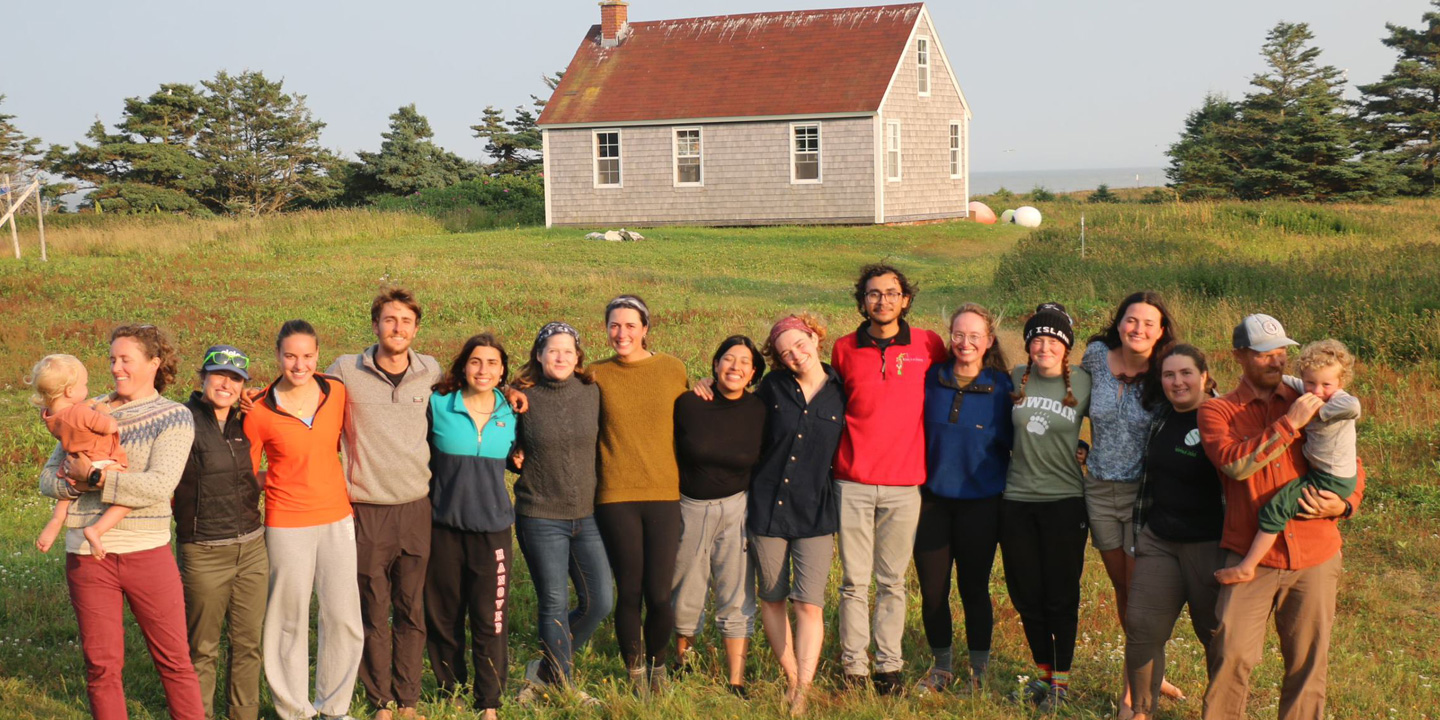
Rustic as it can be at times, students have everything they need to conduct important field research—there is power for laptops and scientific instruments and Wi-Fi connectivity—and many things they couldn’t get anywhere else, namely this kind of hands-on experience as undergrads and access to visiting graduate students, postdocs, and scientists. Director Jones thinks of the BSS on Kent Island in three parts. “First and foremost, we are a scientific research station and an active one,” she says. “We’re finding funding for science and supporting scientists and what they want to do here.”
The second component of what BSS does, says Jones, is to bring undergrads into this dynamic research environment and provide them with experience doing their own independent research project, figuring out how to analyze the data, thinking about designing the methods, and working alongside graduate students and scientists who can share their experiences and perspectives. “They get to do the dishes with them and have that exposure of really getting to know people already in the trenches to ask them, ‘What's grad school like? Why did you decide to do a PhD and how do you pick what you're going to study?’” Jones says. “Undergrads get the opportunity to ask graduate students questions about what that next stage in their career might be like if they decide to go down that road, be it field biology or environmental science or ecology.”
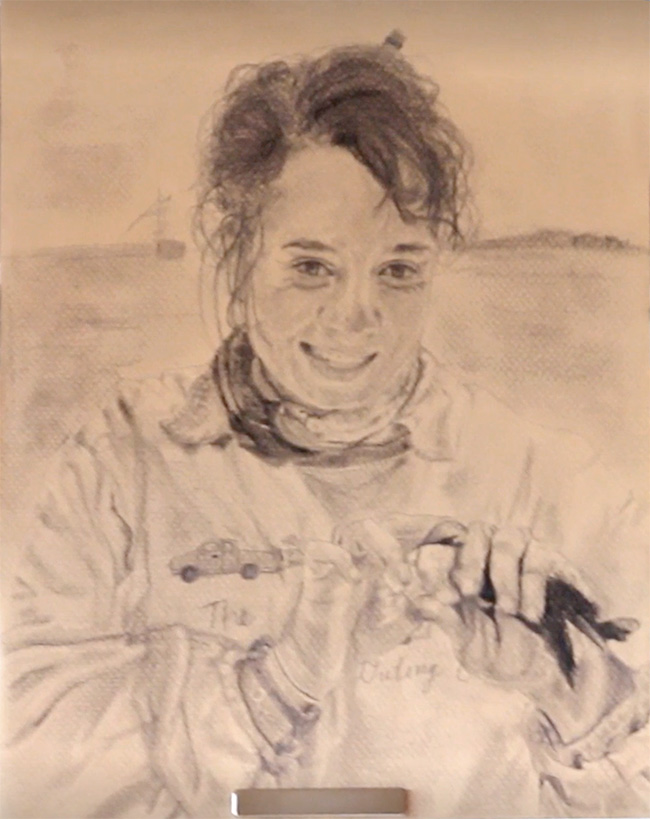
“It is especially unique to be able to come here,” Stretch says. “I've been able to get both real field research experience working in a study site and also been able to meet other people who make science a career and be able to talk to them about their career paths and the different opportunities that are ahead.”
The third component, which is ever-evolving, is thinking about the intersections that exist between science and other ways of engaging with nature. Jones calls it bearing witness to the natural world; that has manifested in poets and artists coming to the island to interact with the undergraduates to explore how their work may converge.
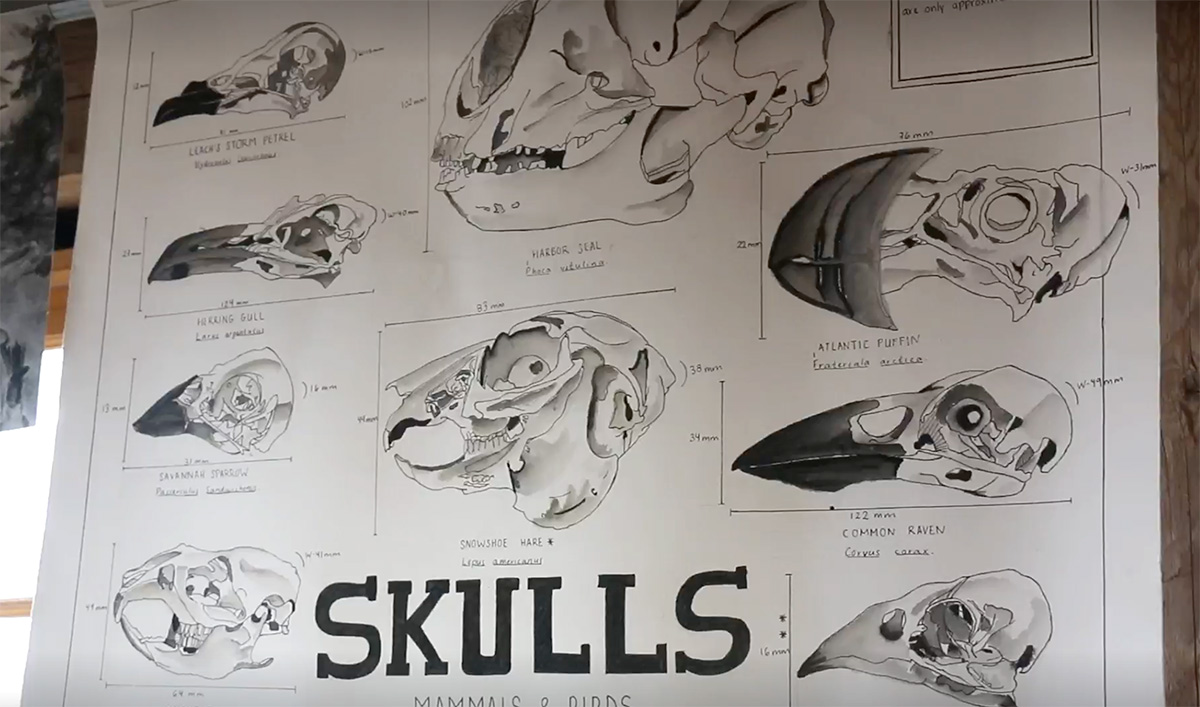
This year’s artist-in-residence, Alison Ambrosio ‘22, an art major and biology minor, is heading to grad school to study medical illustration but this summer is helping with storm-petrel research and collaborating on a children’s book about animal poop and will gleefully share with you that bee poop has the consistency of jelly.
At the end of one fruitful day, Ambrosio is on kitchen duty with Eric Diaz ’23, who spent the rainy morning in the lab with a spectrometer as part of his research into pollinators, specifically the color learning of bumblebees. Over crowd-pleasing burritos that the two had been planning for weeks, students recap the day, which eventually had given way to full sun and an afternoon of productivity. Emma Olney ’25 and Jeremy Hoyne Grosvenor ‘22 were able to inventory patches of forest floor for their forestation projects, and Leila Trummel ’23 made headway in the high school lesson plans she’s creating around her low-bush blueberry pollination research with Neena Goldthwaite ’24. Land stewards Elizabeth Baker ’22 and Elena Sparrow ’22 unloaded a literal boatload of lumber, and after a lesson from Ian Kyle, began to shingle the woodshed.
Meals also often involve a bit of education. While partaking in a variety of classic Canadian butter tarts, students listened to a presentation by Visiting Professor of Art Audrey Shakespear. On the island for ten days seeking inspiration, the sculptor details an ongoing sculpture project upon which she’s been chipping away for five years. The previous evening brought a hands-on knot quiz; following an earlier dinner demonstration of how to tie the useful bowline knot (sometimes referred to as the king of knots because of its importance), lengths of rope were redistributed to see what had stuck. All pass with flying colors, crowned kings and queens of the knot, before conversations resume in the dorm’s living room, where Ian Kyle sometimes plays guitar in front of the wood stove, or around a campfire while roasting marshmallows as the sun sets.
“This is an extremely unique experience that I will never get at any other point in my life,” Leila Trummel ’23.
Life on Kent Island brings opportunity at every turn. These nine-week stretches expose students to real-life research with important implications for science and the environment. The students and their work are critical links in the chain of the Bowdoin Scientific Station’s long legacy of data collection, and in return for their diligence and stewardship, Kent Island provides the kind experience you can only get by doing for yourself, by learning first-hand from those in the field, and by living and sharing this work as part of a community inherently dedicated to studying the present in order to cultivate better futures. It is indeed a haven for many, and a mere stopover for others on dynamic journeys that are just getting started.
The Henry L. and Grace Doherty Charitable Foundation has awarded the College a $1 million challenge grant to support a new Doherty Kent Island Postdoctoral Scholar Program to advance research opportunities at Kent Island.
A $2 million endowment is needed to cover the $100,000 annual costs to support a recent PhD graduate to be a two-year postdoctoral scholar teaching one course on campus each year and mentoring Bowdoin undergraduate summer fellows on Kent Island in the summer.
To learn more about the Doherty Kent Island Postdoctoral Scholar Program and how you can support it, contact Liz Armstrong at liz.armstrong@bowdoin.edu or call 207-725-3172.
“Fogseeker” Gift Secures Future of Kent Island Weather Station
“Right now, it’s the only possible way to judge the sea state out there without being on the water. Everybody uses the weather station, and we all really appreciate it,”
A gift that weathers the passage of time »
Sand, Fog, and Sea Urchins: Drawing Artistic Inspiration from Kent Island
“I have a fondness for patterns and the poetic parallels I see between machines made by humans and structures occurring in nature.”
